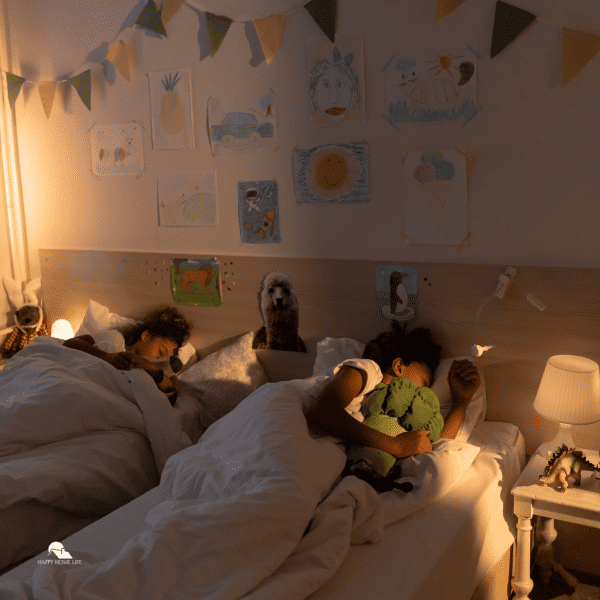Sleep is a cornerstone of healthy development for children, yet it can often become a point of contention between parents and their young ones.
From the days of infancy to the turbulent teen years, sleep needs evolve but the importance of establishing healthy sleep habits remains constant.
This guide aims to delve into three critical facets of children’s sleep: the importance of sleep, the role of afternoon naps, and the significance of having children sleep in their own beds.

The Importance Of Sleep
As any sleep-deprived parent will attest, sleep isn’t just a ‘nice-to-have’, it’s a physiological necessity.
For children, adequate sleep is not only important for physical growth, but it also plays a crucial role in cognitive development and emotional regulation.
A lack of sleep can result in poor academic performance, behavioral issues, and long-term health problems such as obesity and heart disease.
How To Achieve Better Sleep
The pathway to better sleep starts with a consistent bedtime routine.
Establish a calming pre-sleep ritual that can include activities like reading a book, taking a warm bath, or gentle rocking for younger children.
The aim is to signal to the child’s body that it’s time to wind down and prepare for sleep.
Avoid screen time at least an hour before bed as the blue light emitted by electronic devices can interfere with the natural production of the sleep hormone melatonin.
Moreover, make sure that the child’s sleep environment is conducive to rest. This means a dark, cool room, a comfortable mattress, and minimal noise.

The Role Of Diet And Physical Activity
Contrary to popular belief, a late-night snack or a sugary treat before bed doesn’t ‘help’ in falling asleep.
High sugar foods and caffeine can actually interfere with sleep quality. Opt for a light, healthy snack if the child is genuinely hungry before bedtime.
Likewise, regular physical activity can aid in better sleep but try to keep high-energy activities reserved for daytime or early evening to avoid getting the child too worked up before bed.
Significance Of Sleep Schedule
A regular sleep schedule not only helps children fall asleep more easily but also improves the quality of sleep.
Try to keep bedtime and wake-up times consistent even on weekends. Irregular sleep patterns can disrupt the child’s internal body clock and result in poor sleep quality and daytime sleepiness.

The Role Of Afternoon Naps
Napping is a contentious topic in the world of pediatric sleep.
While a well-timed afternoon nap can refresh and revitalize, ill-timed or prolonged napping can interfere with nighttime sleep.
The role of naps varies significantly as children age.
The Ideal Nap Duration
For infants and toddlers, multiple short naps are quite natural.
However, as the child grows, these should consolidate into a single, more extended afternoon nap.
By school age, most children outgrow the need for daytime sleep. For those who still do nap, keeping it to 20-30 minutes can ensure it’s refreshing without affecting nighttime sleep.
Timing Matters
It’s essential to pay attention to when your child naps. Late afternoon naps can interfere with the ability to fall asleep at night.
Aim for a nap that ends at least four hours before the planned bedtime to allow for sufficient sleep pressure to build up.
To Nap Or Not To Nap
Some children may resist afternoon naps, even when they seem tired.
If napping becomes a struggle and the child is consistently sleeping well at night, it may be time to phase out the afternoon nap in favor of an earlier bedtime.

Why Kids Should Sleep In Their Own Beds
Finally, it’s worth discussing why children should sleep in their own beds. This practice can be a sensitive topic for families but it’s vital for several reasons.
Independence And Self-Soothing
When children sleep in their own beds, they learn valuable skills in independence and self-soothing.
These skills are not just essential for sleep but serve them well in various other aspects of life.
Better Sleep Quality For Everyone
Parents often find that they, too, sleep better when children sleep in their own beds.
The frequent movements and sleep disturbances that are common when co-sleeping can disrupt everyone’s sleep, leading to a cycle of sleep deprivation for the entire family.
Marital Harmony
Sharing a bed with a child can often put a strain on a couple’s relationship.
Physical closeness is an essential aspect of marital harmony, and consistently sharing the bed with a child can create emotional and physical distance between partners.

Addressing Common Sleep Obstacles
Navigating the terrain of a child’s sleep is often complicated by several roadblocks that are almost universal.
Be it nightmares, a fear of the dark, or simply the perpetual plea for “five more minutes,” these obstacles can turn bedtime into a battleground.
Tackling these issues head-on can make the process smoother for everyone involved.
Nightmares And Night Terrors
Nightmares are common in children and can disrupt sleep, but it’s essential to differentiate between nightmares and night terrors.
While nightmares occur during REM sleep and can often be remembered, night terrors happen during non-REM sleep and are usually forgotten.
Reassurance and comfort are key in both scenarios. Keeping a soft nightlight or a comforting toy can also provide a sense of security.
Fear Of The Dark
This fear is quite common among young children and can significantly disrupt bedtime routines. Instead of dismissing the fear, try to address it empathetically.
Introduce a soft, non-intrusive nightlight into their room or use storytelling to transform the concept of darkness into something less frightening.
The “Five More Minutes” Plea
Stalling tactics are a classic way for children to push back against bedtime.
The “five more minutes” plea might seem harmless, but it can gradually push bedtime later, disrupting the child’s sleep cycle.
Be firm but fair in enforcing bedtime, perhaps introducing a countdown timer as a visual cue for when it’s time to start winding down.

Final Remarks
Through attention to these three facets of sleep—its importance, the role of naps, and the significance of independent sleeping arrangements—parents can navigate the complex landscape of pediatric sleep.
Each family’s journey will be unique, but the destination—a well-rested child and consequently, a happier family—is well worth the effort.






